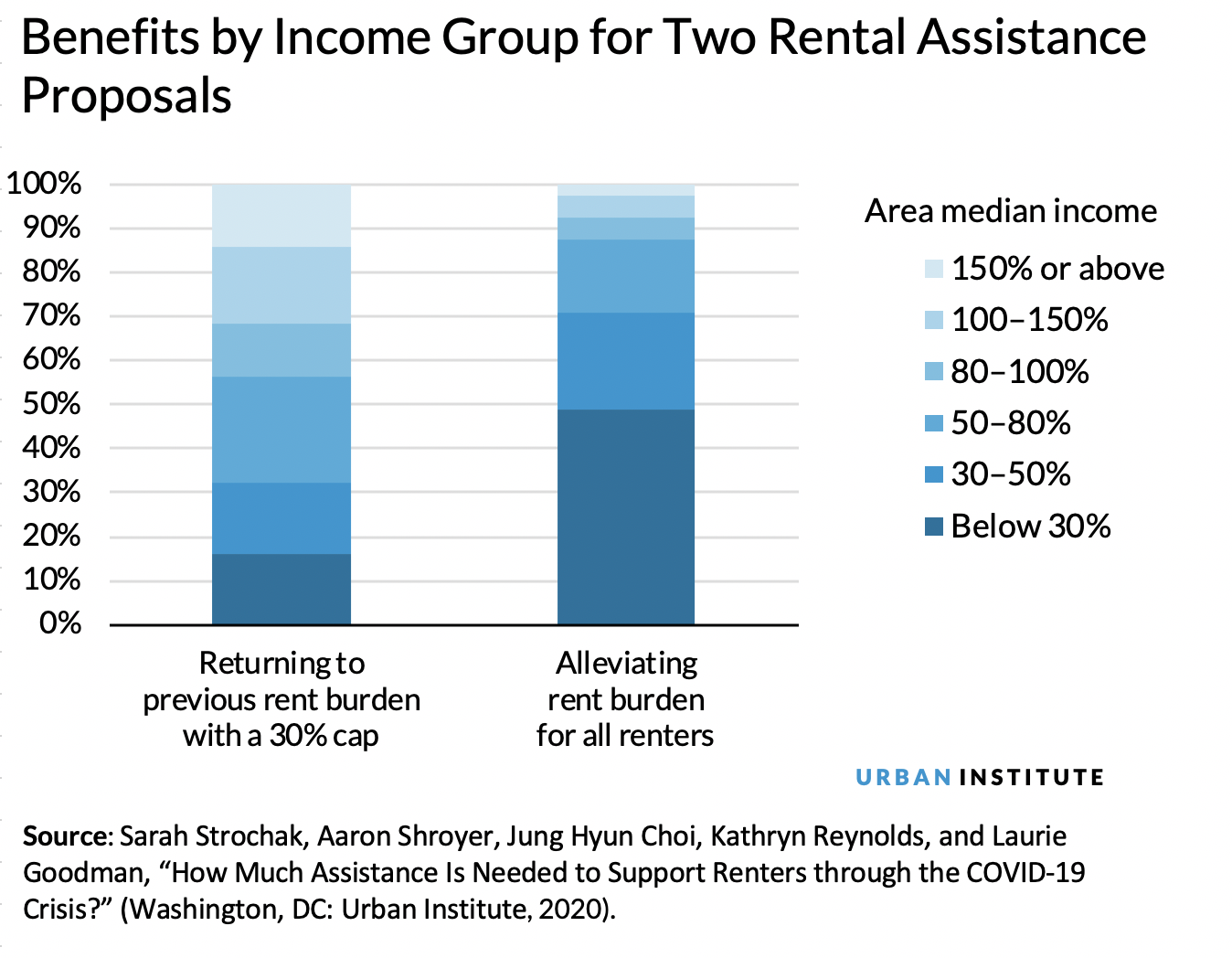
<p>Signs hang from an apartment building in Northwest Washington, DC, on Monday, May 18, 2020. (Photo by Caroline Brehman/CQ-Roll Call, Inc via Getty Images)</p>
The COVID-19 pandemic exacerbated an already severe rental housing crisis. In 2017, nearly half of renters spent more than 30 percent of their income on housing costs, and approximately a quarter paid more than half of their earnings on housing. Compounding this, renters are more likely to be employed in industries vulnerable to employment shocks. The COVID-19 crisis increases both the severity of rent burden and the urgency for assistance.
State and federal unemployment assistance, along with eviction moratoria, have helped most renters pay rent and remain stably housed during the crisis. But renter households face a severe cliff at the end of July, when supplemental unemployment assistance from the Coronavirus Aid, Relief, and Economic Security (CARES) Act expires. In a new brief, we estimate that when state and federal unemployment assistance expires, $15.5 billion per month would be needed to alleviate cost burden for renters who were cost-burdened before the pandemic and for renters who lost their jobs as a result of it.
State and federal unemployment assistance cover much of the housing cost gap for renters who lost jobs but do little to address previously cost-burdened renters
We find that approximately 8.9 million renter households (20 percent of all renter households) had at least one member of the household experience a job loss between February and April. State unemployment insurance and the CARES Act $600 per week supplement make up most of the lost income for the 8.9 million households and help them remain close to their precrisis rent-to-income ratio.
However, most households who were cost burdened before the COVID-19 crisis do not receive unemployment assistance. Much of the current assistance flows to higher-income renter households because they were more likely to have previously participated in the labor force (and were thus more susceptible to job loss). We estimate 45 percent of combined federal and state assistance goes to renter households earning more than 100 percent of the area median income, and unemployment assistance spending per household increases with income.
Rental assistance can help renters who experienced cost burden before and as a result of the pandemic
To alleviate cost burden for all renters, federal policymakers could consider replacing or complementing existing unemployment assistance that provides income supports to households with job losses with rental assistance. Rental assistance also alleviates housing instability and homelessness, which pose significant health risks under normal conditions and have been exacerbated by the pandemic.
We estimate it would cost the federal government $5.5 billion per month in rental assistance to return all renter households to their previous level of rent-to-income burden. This cost drops to $1.8 billion per month in rental assistance if paired with both state unemployment assistance and the CARES Act supplement. To bring all renter households to a 30 percent rent-to-income ratio, a standard used by the US government for housing affordability, rental assistance would cost the federal government $15.5 billion per month. And because renter households at the lowest income levels do not receive unemployment assistance, $11.9 billion per month would still be needed if paired with existing state unemployment assistance and the CARES Act $600 weekly supplement.

Assistance, regardless of how it is targeted and implemented, will help avoid a dire rent cliff
Based on the unemployment rate, researchers from Columbia University estimate that homelessness could increase by between 40 and 45 percent this year. So far, assistance from the CARES Act and state unemployment assistance have helped renters avoid the worst effects. But when unemployment insurance under the CARES Act expires on July 31 and state unemployment assistance follows suit later this year, federal policymakers must consider how best to provide assistance to renters, which subset of the population to target, and whether their goal is to return renters to precrisis cost burdens or, given the health concerns of the current crisis, alleviate a greater share of their burden.
Let’s build a future where everyone, everywhere has the opportunity and power to thrive
Urban is more determined than ever to partner with changemakers to unlock opportunities that give people across the country a fair shot at reaching their fullest potential. Invest in Urban to power this type of work.